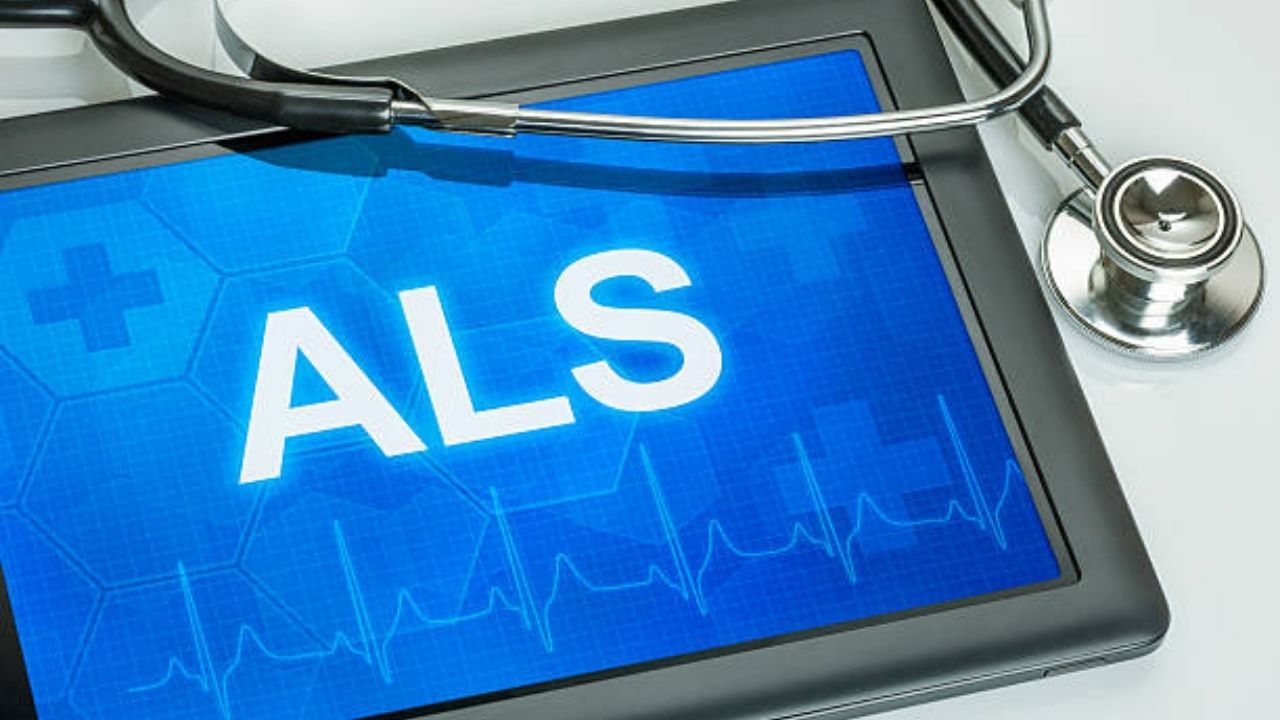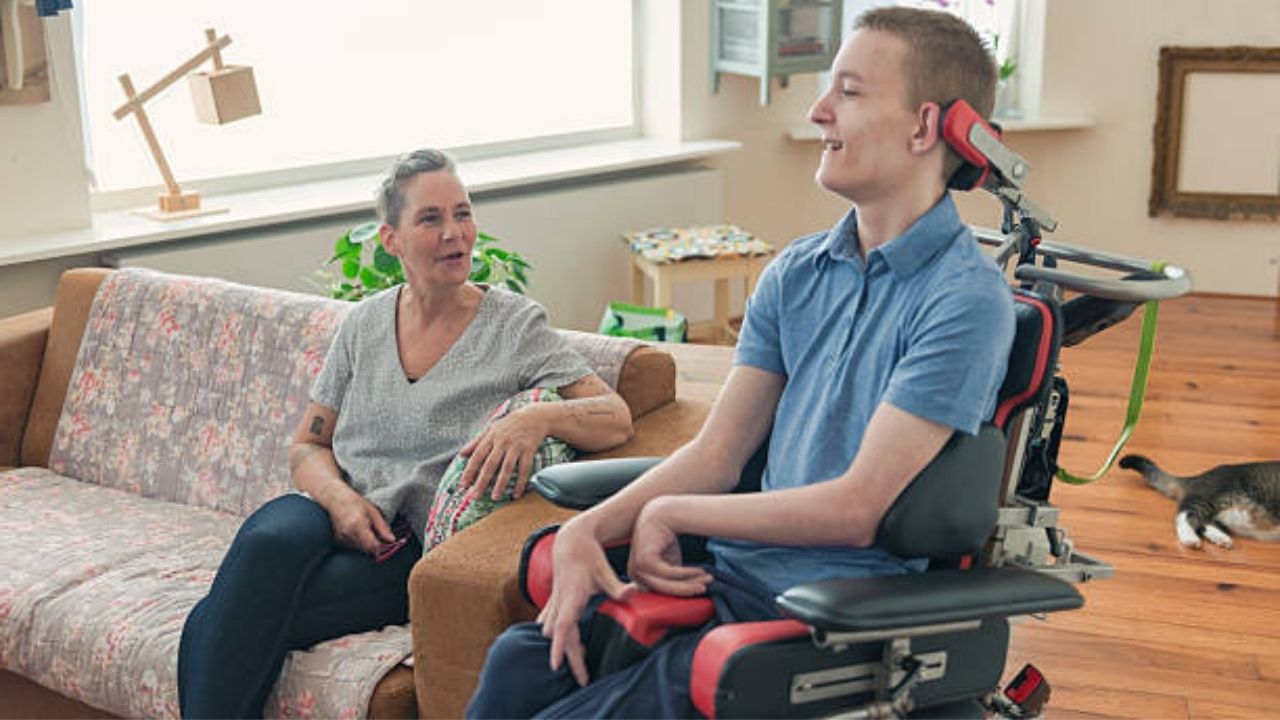Amyotrophic lateral sclerosis (ALS) is a chronic degenerative disease of the central nervous system. Due to the loss of certain nerve cells, those affected suffer from progressive muscle paralysis. They are confined to a wheelchair early on, later they have difficulty swallowing, speaking or breathing. In many cases, ALS leads to death within a few years. But there are also people like astrophysicist Stephen Hawking who have lived with the disease for decades. Read more about the signs and treatment of amyotrophic lateral sclerosis here.
ICD codes for Amyotrophic lateral sclerosis disease: G12
Quick overview
• Symptoms: muscle weakness and muscle wasting, later signs of paralysis, spasms, speech and swallowing disorders, breathing difficulties.
• Therapy: The disease cannot be treated causally, but effective measures are available to alleviate the symptoms.
• Causes: The causes are not known to this day. Some sufferers have an enzyme defect that leads to the accumulation of free oxygen radicals.
• Course of the disease: The course of the disease varies greatly from person to person, but life expectancy is usually severely limited.
• Prevention: Due to the unknown cause, the disease cannot be prevented.
What is amyotrophic lateral sclerosis?
Amyotrophic lateral sclerosis (also known as ALS, myatrophic lateral sclerosis, Charcot’s disease or Lou Gehrig’s syndrome) has been known as a nervous disease since the mid-19th century. It is relatively rare compared to other neurodegenerative diseases. According to expert estimates, about two out of 100,000 people fall ill every year, and men are affected a little more often than women. The number of new cases is higher in Europe than in other parts of the world.
In most cases, amyotrophic lateral sclerosis occurs between the ages of 50 and 80. As the disease progresses, the nerve cells (neurons) responsible for sending commands to the muscles gradually die. This process is no longer reversible. The commands from the brain and spinal cord become weaker and weaker and are passed on to the muscles with increasing delay. Amyotrophic lateral sclerosis therefore first manifests itself as muscle weakness, and later also as signs of paralysis.
In most people, amyotrophic lateral sclerosis has no negative effects on mental abilities: sensory perception, consciousness and thinking skills remain completely intact. Only about five percent suffer from memory loss. However, it is all the more stressful for many of those affected when they are no longer able to cope with their everyday life on their own during the course of the ALS disease.
There is no cure for amyotrophic lateral sclerosis, and those affected usually die of the consequences within a few years.
The three types of amyotrophic lateral sclerosis
Experts distinguish between three forms of amyotrophic lateral sclerosis:
- Sporadic form (about 90 to 95 percent of cases): Amyotrophic lateral sclerosis has no identifiable cause.
- Familial form (about five to ten percent of cases): Amyotrophic lateral sclerosis is caused by a change in genetic information (mutation). These can arise spontaneously or be inherited from parent to child.
- Endemic form: For reasons that have not yet been clarified, ALS disease is significantly more common in some areas of the western Pacific.
What are the symptoms of ALS?
The clinical picture of ALS differs significantly among those affected. In addition, the symptoms of ALS change over the course of the disease.
Early symptoms of ALS
25 percent of those affected initially complain of muscle weakness and muscle wasting in the small hand muscles and later in the arm muscles. Amyotrophic lateral sclerosis is also characterized by cramps in the legs and a reduction in the facial muscles. In other people, however, the early symptoms of ALS first become noticeable in the feet and legs and only later spread to the arms and facial muscles.
In about 20 percent of those affected, a decreasing ability to speak and swallowing disorders (bulbar paralysis) first appear. Those affected speak increasingly more slowly and slurred (bulbar language). Muscle strength and volume in the extremities only decrease later.
Other symptoms of amyotrophic lateral sclerosis are involuntary movements and uncoordinated twitching of individual muscle bundles (fasciculations). Some people with ALS start laughing or crying uncontrollably.
Symptoms in the course of the disease
In the later stages, all forms of ALS are characterized by paralysis. Many people lose a lot of weight (cachexia), and some sufferers experience limitations in mental performance. However, these are usually only slightly pronounced.
As the disease progresses, paralysis of the respiratory muscles becomes increasingly noticeable. Those affected then suffer, for example, from shortness of breath, sleep disorders, morning headaches, daytime tiredness and difficulty concentrating. Since more secretion builds up in the respiratory tract, there is a higher susceptibility to infection. The function of the bladder and intestines is preserved in many of those affected.
Does ALS cause pain?
As a result of muscle spasms and spasticity, ALS often causes pain as the disease progresses. These are individually different in severity and often additionally restrict resilience and mobility. Those affected describe the pain as pulling, cramping or stabbing. In a recent study, people with ALS primarily reported about
• Neck pain (40 percent).
• Pain in the shoulders (30 percent).
• Low back and buttock pain (40 percent).
• Leg pain (40 percent).

How is ALS treated?
The disease amyotrophic lateral sclerosis (ALS) cannot be cured. The goal of treatment is therefore to enable those affected to live as long, independently and symptom-free as possible.
Patients receive the best care in a clinic that has an interdisciplinary team available for the treatment of amyotrophic lateral sclerosis (neuromuscular centers). In addition to specialists in nerve diseases (neurologists), these include gastrointestinal specialists (gastroenterologists), lung specialists (pulmonologists), specialists in heart diseases (cardiologists), orthopedists, speech therapists (speech therapists), psychologists, physiotherapists and ergotherapists or dieticians.
The active ingredient riluzole is currently the only recommended causal therapy for amyotrophic lateral sclerosis. Although it does not allow healing, it is able to protect the nerve cells from further damage. Riluzole delays the course of ALS by a few months. The earlier the therapy starts, the more it reduces the symptoms. The drug increases life expectancy and quality of life considerably. Other active ingredients are currently undergoing clinical testing.
Symptomatic therapy
Since amyotrophic lateral sclerosis progresses very differently from person to person, those affected also suffer from very different symptoms that require individual treatment. Many patients develop breathing problems and suffer from shortness of breath because the respiratory muscles no longer function adequately. In this case, a ventilator and anti-congestion drugs (mucolytics) help. Preventative measures against pneumonia such as breathing exercises, tapping massages or cough aids are often useful.
In the course of the disease, problems with swallowing often necessitate artificial nutrition. This is done either via infusions (via the vein) or via a so-called PEG tube that leads through the abdominal wall directly into the stomach.
Many people affected by ALS experience increased salivation (hypersalivation). Drugs that dampen the influence of the parasympathetic nervous system are suitable for treatment. This is the part of the autonomic nervous system that controls most of the internal organs and, among other things, stimulates the flow of saliva.
Physiotherapy and occupational therapy are also used for amyotrophic lateral sclerosis. They are said to promote remaining skills, relieve symptoms such as uncontrolled muscle twitching and cramps and reduce the risk of clot formation in the veins of the legs (thrombosis). Pain can usually be controlled well with strong painkillers (e.g. opioids). In the case of severe cramps and spasticity, antispasmodic and muscle-relaxing drugs are available.
In addition to drug therapy with psychotropic drugs, supportive psychotherapy makes sense for the treatment of psychological symptoms such as depression and panic attacks .
Aids in ALS
In addition to the therapeutic measures, there are various aids that offer support to ALS sufferers in various areas of life. They help to increase mobility and maintain independence for longer. Examples of important tools are
• Walking stick, walker or – in the later stages of the disease – an electric wheelchair.
• Sitting and standing up aids.
• Electrical control systems for windows, doors, lights or heating, for example.
• Communication boards and computerized communication aids.
• Care beds.
• Commode chair or raised toilet seat.
• Shower chair or bath lift.
• Donning and doffing aids.
• Eating and drinking aids.
Causes and risk factors of amyotrophic lateral sclerosis
Amyotrophic lateral sclerosis has long been known as a nervous disease, but the causes of the disease are still largely unclear. Although there may be an accumulation of cases in families with a predisposed family history, the majority of ALS cases occur spontaneously.
About one in 100 people with ALS has an inherited or new change (mutation) in a specific gene (SOD-1) that is important for cell metabolism. The mutation disrupts the formation of an enzyme that scavenges oxygen free radicals in the cell. These are harsh chemical compounds that attack the body’s cells and tissues. If the enzyme is defective as a result of a genetic mutation, the accumulating free radicals can damage the nerve cells considerably.
Amyotrophic lateral sclerosis: Investigations and diagnosis
The ALS diagnosis requires various medical examinations. Some of these are always required, other tests are only necessary in some cases to rule out diseases with similar symptoms (differential diagnosis).
Typical examinations for suspected amyotrophic lateral sclerosis are:
• Tests of nerve functions (reflexes, muscle tension, touch, bladder and bowel control).
• Test of mental and intellectual performance.
• Recording of electrical muscle activity (electromyography and neurography).
• Blood tests, especially to rule out other diseases.
• Test of lung function, possibly also a blood gas analysis.
• Magnetic resonance imaging (to differentiate ALS disease from other nerve diseases).
• Determination of body weight and body mass index (BMI).
An ALS diagnosis can also be further confirmed with the following tests:
• Muscle biopsy (structure of muscle fibers).
• Testing for dementia.
• Magnetic stimulation of the motor areas of the brain (transcranial magnetic stimulation).
• Examination of blood and liquor for various pathogens (e.g. Borrelia, HIV or Lues) or antibodies against these pathogens.
• Examination of the ear, nose and throat (differential diagnosis: speech and swallowing disorders).
• Other imaging procedures (e.g. magnetic resonance imaging of the brain and spinal cord).
• Blood tests for metabolic disorders.
• Removal of bone marrow (bone marrow biopsy).
A DNA test for an altered SOD-1 gene is particularly useful in young patients with a rapid course of the disease, especially to rule out other diseases with certainty.
If a doctor diagnoses ALS, it may make sense for those affected to obtain the opinion of another expert because of its immense importance.
Course of the ALS disease and prognosis
To date, there is no cure for ALS. The life expectancy of people with amyotrophic lateral sclerosis (ALS) can hardly be predicted due to the different course of the disease. Most of those affected die within two to five years after diagnosis, the cause is often the weakness of the respiratory muscles (respiratory insufficiency). However, about ten percent of those affected survive significantly longer, in some cases more than ten years.
Due to the usually severe course of the disease, it is advisable for those affected to seek psychological support. In addition to doctors, ALS self-help groups also offer advice and help.
If amyotrophic lateral sclerosis is diagnosed early so that immediate treatment is possible, many of those affected have a very high quality of life. If good care is ensured in the home environment, patients only need inpatient treatment in the clinic in the late phase of amyotrophic lateral sclerosis.
Prevention of amyotrophic lateral sclerosis
Since the cause of the disease is not known, it is not possible to specifically prevent ALS.
